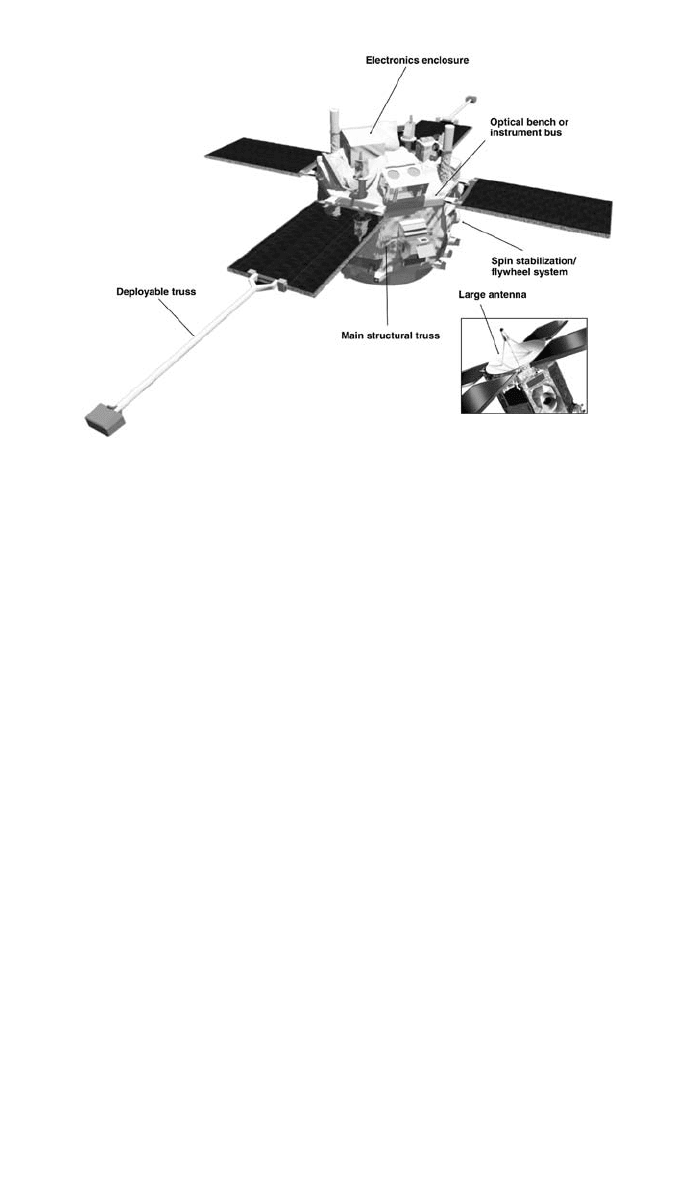Kutz M. Handbook of materials selection
Подождите немного. Документ загружается.


BIBLIOGRAPHY 1127
approach to nanophase ceramics materials are the simple processing steps, the
flexibility of solution chemistry, the low-temperature treatments, and small in-
vestment in equipment.
When considering where sol–gel materials are used, most of the applications
are substitutions of a sol–gel material for a ceramic obtainable by other means.
Nevertheless, there are some applications that are unique to sol–gel processing,
such as porous materials for membranes or infiltration and organic–inorganic
hybrids.
4 SUMMARY AND PROJECTIONS
In the end, the choice of what method to use depends on many factors. Accord-
ing to the SP
3
paradigm, performance is the ultimate test of synthesis and proc-
essing. Therefore, choices are made on the basis of how easily the process can
be optimized for chemical properties or physical properties. Other considerations
are the availability of the appropriate raw materials or precursors and the avail-
ability of the processing equipment. The advanced processing schemes in many
cases require high-temperature furnaces or reactive atmospheres. Difficulty gain-
ing access to this equipment or conditions may prohibit the use of an advanced
process. Similarly, problems of scale-up in size or number of components may
make a conventional process more straightforward than an advanced process.
Finally, time and cost are factors in the decision whether or not to use an ad-
vanced process. Nevertheless, there continue to be signs of progress in all of the
advanced processes described, with some, such as microwave processing, in
more widespread use than others, such as layered manufacturing. As with any
new technology, change is slow, but competition from other materials is a strong
incentive for advanced processing of ceramics.
Acknowledgments
Some of the ideas for this chapter come from the Materials Science Summer
Institute (MASSI) ‘‘Intelligent Manufacturing of Nanostructured Ceramics,’’
June, 1996, sponsored by Rutgers University, Princeton University, and the Uni-
versity of Pennsylvania, and funded by NSF. My thanks go to the MASSI ‘‘stu-
dents’’ and co-organizer, Rik Riman, for outstanding ideas and discussions.
BIBLIOGRAPHY
Agarwal, M., M. R. DeGuire, and A. H. Heuer, J. Am. Ceram. Soc., 80, 2967 (1997).
Allen, S. M., and E. L. Thomas, The Structure of Materials, Wiley, New York, 1999.
Bandyopadhyay, A., R. K. Panda, V. F. Janas, M. K. Agarwala, S. C. Danforth, and A. Safari, J. Am.
Ceram. Soc., 80, 1366 (1997).
Barsoum, M. W., Fundamentals of Ceramics, McGraw-Hill, New York, 1997.
Blum, Y. D., K. B. Schwartz, and R. M. Laine, J. Mater. Sci., 24, 1707 (1989).
Brinker, C. J., and G. W. Scherer, Sol–Gel Science, Academic, Boston, 1990.
Brinker, C. J., Y. Lu, A. Sellinger, and H. Fan, Adv. Mater., 11, 579 (1999).
Clark, D. E., and W. H. Sutton, Ann. Rev. Mat. Sci., 26, 299 (1996).
Gelabert, M. C., B. L. Gersten, and R. E. Riman, J. Crystal Growth, 211, 497 (2000).
Gilman, P. S., and J. S. Benjamin, Ann. Rev. Mat. Sci., 13, 279 (1983).
Gleiter, H., Acta Mater., 48, 1 (2000).
Glumac, N. G., G. Skandan, Y. J. Chen, and B. H. Kear, Nanostructured Materials, 12, 253 (1999).
Greil, P., J. Am. Ceram. Soc., 78, 835 (1995).
Hahn, H., Nanostructured Materials, 2, 29 (1993).

1128 ADVANCED CERAMICS PROCESSING
Hahn, H., Nanostructured Materials, 9, 3 (1997).
Holt, J. B., and S. D. Dunmead, Ann. Rev. Mat. Sci., 21, 305 (1991).
Katz, J. D., Ann. Rev. Mat. Sci., 22, 153 (1992).
Klein, L. C. (ed.), Sol–Gel Optics, Processing and Applications, Kluwer Academic, Boston, 1994.
Klein, L. C. (ed.), Sol–Gel Technology for Thin Films, Fibers, Preforms, Electronics and Specialty
Shapes, Noyes Publications, Park Ridge, NJ, 1988.
Lange, F. F., J. Am. Ceram. Soc., 72, 3 (1989).
Lee, S. E., J. M. Xue, D. M. Wan, and J. Wang, Acta Mater., 47, 2633 (1999).
Lewis, J. A., J. Am. Ceram. Soc., 83, 2341 (2000).
McCormick, P. G., and F. H. Froes, JOM, 11, 61 (1998).
Munir, Z. A., Am. Ceram. Soc. Bull., 67, 344 (1988).
Nagelberg, A. S., S. Antolin, and A. W. Urquhart, J. Am. Ceram. Soc. 75, 455 (1992).
Pierre, A. C., Introduction to Sol-Gel Processing, Kluwer Academic, Boston, 1998.
Rahaman, M. N., Ceramic Processing and Sintering, Marcel Dekker, New York, 1995.
Reed, J. S., Principles of Ceramic Processing, Wiley, New York, 1995.
Richerson, D. W., Modern Ceramic Engineering, Marcel Dekker, New York, 1992.
Riman, R. E., M. M. Lencka, L. E. McCandlish, B. L. Gersten, A. Anderko, and S. B. Cho, Rev.
High Pressure Sci. Technol., 7, 1358 (1998).
Schneider, S. J. (ed.), Engineered Materials Handbook, Vol. 4, Ceramics and Glasses, ASM Inter-
national, Metals Park, OH, 1991.
Siegel, R. W., Ann. Rev. Mat. Sci., 21, 559 (1991).
Sigmund, W. M., N. S. Bell, and L. Bergstrom, J. Am. Ceram. Soc., 83, 1557 (2000).
Song, J. H., M. J. Edirisinghe, J. R. G. Evans, J. Am. Ceram. Soc., 82, 3374 (1999).
West, J. K., and L. L. Hench, Principles of Electronic Ceramics, Wiley, New York, 1990.
Wu, M. J., and L. V. Interrante, Macromolecules, 25, 1840 (1992).
Wu, S., D. Holz, and N. Claussen, J. Am. Ceram. Soc., 76, 970 (1993).
Wynne, K. J., and R. W. Rice, Ann. Rev. Mat. Sci., 14, 297 (1984).
Yi, H. C., and J. J. Moore, J. Mater. Sci., 25, 1159 (1990).

PART 7
APPLICATIONS AND USES
HandbookofMaterialsSelection.EditedbyMyerKutz
Copyright Ó 2002 John Wiley & Sons, Inc., NewYork.

1131
CHAPTER 36
SPACECRAFT APPLICATIONS OF
ADVANCED COMPOSITE MATERIALS
Kevin R. Uleck
Department of Aerospace Engineering
University of Maryland
College Park, Maryland
Paul J. Biermann
Jack C. Roberts
Bonny M. Hilditch
Applied Physics Laboratory
The Johns Hopkins University
Laurel, Maryland
1 INTRODUCTION 1131
1.1 Advanced Composites 1132
1.2 Unique Benefits of Advanced
Polymer Matrix Composites 1135
1.3 Scope 1136
2 USE OF ADVANCED
FIBER-REINFORCED
COMPOSITES IN SPACECRAFT 1137
2.1 Properties /Characteristics for
Space Applications 1137
2.2 Typical Structures 1142
2.3 Manufacturing 1146
3 EXAMPLE SPACECRAFT
APPLICATIONS 1149
3.1 Primary Spacecraft Bus /Chassis
Structure 1150
3.2 Deployable Structures 1152
3.3 Electronics Enclosures 1153
3.4 Optical Benches and Instrument
Structures 1157
3.5 Antennas, Reflectors, and
Mirrors 1159
REFERENCES 1162
1 INTRODUCTION
Many rigorous demands are placed on the design of spacecraft structures. They
must be lightweight to maximize the allowable payload mass while being stiff
enough to maintain precision alignment of instruments under severe orbital en-
vironmental conditions. Launch loads often dictate strength requirements that
are much greater than those needed for space operation. In today’s economic
environment the time and funding available for project completion are reduced,
and more requirements are being placed on the designer. Advanced composite
materials are being used more frequently and in more diverse applications to
assist in meeting these demands, such as those shown in Fig. 1. Effective use
of advanced composites often requires that the analyst, designer, and fabricator
work together to reduce costs, optimize structural performance, and minimize
mass.
HandbookofMaterialsSelection.EditedbyMyerKutz
Copyright Ó 2002 John Wiley & Sons, Inc., NewYork.

1132 SPACECRAFT APPLICATIONS OF ADVANCED COMPOSITE MATERIALS
Fig. 1 Common applications of advanced composites on spacecraft structures.
This chapter consists of three sections. Section 1 briefly describes the basic
characteristics and properties of advanced composites. Section 2 focuses on the
specific properties of advanced composites that are important for spacecraft op-
eration. Examples of typical spacecraft structures constructed in part or entirely
from advanced composite materials are given in Section 3.
1.1 Advanced Composites
A composite material is generally defined as a man-made material composed of
two or more distinct components. The term advanced composites generally refers
to materials consisting of high-stiffness continuous-fiber reinforcements within
a comparatively weak matrix. The reinforcing fibers are generally much stronger
and stiffer than the matrix and are the primary drivers for the unidirectional
tensile and compressive stiffness and the strength of the material. The primary
role of the matrix is to provide a load transfer mechanism between fibers. When
fibers and matrices are combined to form a composite material, the result is a
material with properties that are more than simply the sum of the individual
components. Properly selected fiber and matrix combinations complement each
other and work together to form materials that have unique and valuable prop-
erties.
Advanced composites consist of several thin plies (lamina) stacked together
to form a laminate. The individual laminae (plies) are orthotropic and trans-
versely isotropic, with the strength and stiffness values in the fiber direction
being an order of magnitude or greater than the corresponding values in the
direction transverse to the fibers. Each ply within the laminate can be oriented
at a different angle to create a laminate that meets the structural requirements
desired while using the minimum amount of material. Additionally, plies of
different materials can be combined into one laminate, or individual plies can
be hybridized to obtain the best material combination.

1 INTRODUCTION 1133
The constitutive stress–strain equations for composite laminates are much
different than those for isotropic materials. For laminates the traction (tensile/
compressive) forces per unit width are coupled with the moments per unit width.
Classical laminated plate theory is used to describe the behavior of composite
laminates assuming plane stress conditions (Eqs. 1 and 2):
0
兩N 兩 ⫽ 兩A 㛳 㛳 ⫹ 兩B 㛳
兩 (1)
iijj ijj
0
兩M 兩 ⫽ 兩B 㛳 兩 ⫹ 兩D 㛳
兩 (2)
iijij ijj
In this set of equations, i, j ⫽ 1, 2, 3 and N
i
are the in-plane tensile/compressive
forces per unit width on the laminate, M
i
are moments per unit on the laminate,
A
ij
, B
ij
, D
ij
, are the constituent matrices, and ,
j
are the reference-plane strain
0
ij
and laminate curvature. The moments and the forces are coupled through the
bending-coupling stiffness matrix. In its current form, as tensile forces are ap-
plied, the laminate will warp due to the coupling. If the B matrix is identically
equal to zero, the extension and bending equations become decoupled, therefore
physical bending and extension are independent of each other. The laminate can
then be designed (through proper use of fiber orientations in the lamina) to take
advantage of this coupling/uncoupling to produce the desired effects. The A, B,
and D matrices relate the lamina properties to the laminate properties by way
of the material properties and laminate thickness. An example is given below
for the calculation of extensional stiffness matrix, A
ij
:
n
A ⫽ (Q )[h ⫺ h ] (3)
冘
ij ij k k k
⫺
1
k
⫽
1
where n ⫽ the number of plies (lamina), and h
k
⫽ the distance from the top of
the kth ply to the laminate reference-plane; is the ply-transformed stiffness
(Q )
ij
matrix, which directly relates to the material properties of the ply in laminate
axes. An example is shown below for the calculation of the transformed matrix:
4224
Q ⫽ Qm⫹ 2(Q ⫹ Q )mn ⫹ Qn (4)
11 11 12 66 22
where m and n are the direction cosines in the transformation and the ply stiff-
ness (Q
ij
) values are represented by:
Q
⫽ E /(1 ⫺
) (5)
11 11 12 21
Q ⫽ E /(1 ⫺
) (6)
22 22 12 21
Q ⫽ E
/(1 ⫺
) (7)
12 11 12 12 21
Q ⫽ G (8)
66 12
where E, G, and
are the familiar elastic modulus, shear modulus, and Poisson
ratio for the different material directions (longitudinal or transverse to the fibers)
in each of the plies. Several texts are available that describe classical laminated

1134 SPACECRAFT APPLICATIONS OF ADVANCED COMPOSITE MATERIALS
plate theory and composite mechanics in detail, such as Mechanics of Composite
Materials.
1
Reinforcement Fibers
The majority of reinforcement fibers belong to one of four families: carbon
fibers, aramid (aromatic polyimide) fibers, glass fibers, and specialty exotic fi-
bers. Special reinforcement fibers such as boron and alumina fibers are some-
times used for niche applications but are not widely used due to a variety of
reasons such as low availability, high cost, and nonstandard handling require-
ments. In spacecraft applications, carbon fibers are used far more frequently than
aramid or glass because they have the best combination of specific strength,
specific stiffness, cost, and handling characteristics. There are, however, some
applications where aramid or glass fibers are better suited, such as those where
thermal isolation, corrosion resistance, or toughness are critical design factors.
Glass fibers were the first fibers to be used extensively as reinforcements in
composite materials. They are relatively inexpensive, widely produced, and fre-
quently used today in applications where low cost is a primary requirement,
such as in the automotive and recreation industries. Different grades of glass
fibers are available, the most common being E-glass, which provides good per-
formance at moderate prices. S-glass fibers provide higher strength and stiffness
than E-glass but at a significantly higher cost. Although glass fibers have been
used extensively in aerospace applications, they have been replaced by stiffer
and higher strength carbon and aramid fibers in modern high-performance aero-
space applications.
Aramid fibers, such as DuPont’s Kevlar fiber, were introduced commercially
in the early 1970s.
2
Filament wound pressure vessels and lightly loaded second-
ary aircraft structures were early applications for aramid fibers. A unique feature
of these fibers is that they are remarkably damage tolerant. The tensile failure
of aramid fibers is characterized by fibrillation and a large amount of energy
can be absorbed before material failure. This property makes aramid fibers es-
pecially useful in situations where properties of energy absorption or dispersion
are critical, such as micrometeoroid impact protection.
Carbon fibers are the most frequently used reinforcement in high-performance
composite materials today. A broad selection of carbon fibers encompassing a
range of strength, stiffness, thermal, and electrical properties is available. Carbon
fibers are grouped into two families according to the precursor material from
which they are made: (1) synthetic polymer fiber precursors and (2) pitch-based
fiber precursors. The first carbon fibers were produced by pyrolysis of rayon in
1959 by Union Carbide. In the early 1960s, mass-produced fibers appeared,
produced from the pyrolysis of PAN (polyacrylonitrile), a synthetic precursor.
Less expensive carbon fibers made from a pitch base have been produced since
1973.
3
PAN fibers offer higher strength, stiffness, and improved manufacturing
consistency over pitch-based fibers. Consequently, they are the fibers of choice
for most high-performance composite applications. On the other hand, refine-
ments in the production of pitch-based fibers have produced carbon fibers with
much better thermal and electrical conductivity than is possible in PAN fibers.
Although these advanced pitch-based fibers still do not equal the strength and
stiffness of PAN fibers, they are indispensable for applications that require good
thermal conductivity, such as electrical enclosures.

1 INTRODUCTION 1135
Table 1 Properties of Common Polymer Matrix Materials
Matrix Material
Tensile Strength
(MPa)
Tensile Modulus
(MPa)
Service
Temperature
(⬚C)
Epoxy 1 50 3100 140
Epoxy 2 90 3800 245
Polyester 1 75 3380 90
Cyanate ester 1 80 3600 240
Thermoplastic 100 3900 150
To ease manufacturing and improve the bond between the fiber and the poly-
mer matrix, all reinforcement fibers are available with various surface treatments.
These treatments include epoxy sizing for carbon fiber, silane coupling agents
for glass fiber, and plasma etching for aramid fiber surfaces. Reinforcement
manufacturers work closely with their customers to select or develop the appro-
priate surface treatment for optimization of material behavior for a given appli-
cation.
Polymer Matrices
The majority of current advanced fiber-reinforced composite materials employ
thermoset or thermoplastic polymers as the matrix material. Table 1 lists some
properties of common polymer matrix materials used in advanced composites.
Thermosetting polymers are characterized by chemical cross-links between
molecular chains. These cross-links are formed during the resin curing process
and are primarily responsible for the mechanical properties of the cured polymer.
Thermoplastic polymers do not have chemical cross-links, and their rigidity de-
pends on the mechanical interaction of highly intertwined molecular chains.
Properties of new high-performance thermoplastics match or exceed many tra-
ditional thermosetting polymer properties, but these are often more difficult to
use because of the very high temperatures and pressures required.
Thermosetting epoxies have been the dominant matrix material for advanced
aerospace applications due to the wide-ranging combination of mechanical prop-
erties, processing and handling characteristics, and variety of formulations avail-
able. Lately, polycyanate thermoset matrix materials are replacing epoxies
because they are much more durable in the space environment (see discussion
in Section 2.1 on environmental durability). Advanced thermoplastics have been
used in some space applications, but their use has been limited due to processing
complexity.
Many aspects must be factored into the polymer matrix selection for a par-
ticular composite material application. The material properties that are important
for composite material applications differ from application to application and
can include service temperature range, environmental durability, toughness,
strength, stiffness, compatibility with fiber sizing, availability, processing char-
acteristics, and cost.
1.2 Unique Benefits of Advanced Polymer Matrix Composites
Advanced fiber-reinforced composite materials have several key properties that
make them especially useful in spacecraft applications. Their high specific

1136 SPACECRAFT APPLICATIONS OF ADVANCED COMPOSITE MATERIALS
Table 2 Comparison of Specific Properties of Metals and Composites
Material Specific Tensile Strength Specific Tensile Stiffness
AL 2024-T3 174 26
AL 6061-T6 115 26
Ti-6Al-2Nb-1Ta-1Mo 184 25
T-600 Stainless Steel 127 25
Quasi-isotropic Gr / Ep 258 50
strength and stiffness (strength/density, stiffness/density, examples are given in
Table 2) allow spacecraft structure designs that are lighter than traditional metal
structures. Structural mass may be reduced by more that 50% over comparable
metal structures through the use of advanced composites. Because the total mass
of a spacecraft is limited, the minimization of the structural mass of the space-
craft can extend the spacecraft life by allowing larger fuel loads, or more mass
may be allotted for scientific payloads.
While simply replacing metal components with quasi-isotropic composite
laminates can result in reduced mass, the exploitation of the directional nature
of advanced continuous fiber composite materials results in designs that are
much more structurally efficient. A structure made from isotropic metals is gen-
erally sized according to Von Mises loading principals. This often leads to struc-
tures being dramatically overdesigned in the nonprinciple loading directions.
Composites are much stronger and stiffer in the direction parallel to the fibers
(longitudinal) than the direction transverse to them. Designers can take advan-
tage of this directional strength to produce structures with equal margins of
safety for all loading directions. In this way, the use of anisotropic composite
materials leads to a more efficient, lower mass design.
Another extremely useful trait of advanced composites is that the thermal
expansion properties can be customized. Carbon and aramid fibers have a neg-
ative axial coefficient of thermal expansion (CTE), so composite structures using
carbon fiber or aramid fiber reinforcements can be designed that have ultralow
thermal expansion. Spacecraft are typically subjected to a wide temperature
range as they move in and out of direct solar radiation. The use of metallic
structures in this environment can lead to substantial dimensional changes that
disturb instrument alignment and induce stresses. The use of composites with
customization of the coefficient of thermal expansion permits the design of pre-
cision structures and assemblies that function uniformly over the whole temper-
ature range.
1.3 Scope
The aim of this chapter is to discuss the benefits of using advanced composite
materials in spacecraft structures and to provide examples of typical applications.
Advanced composites can consist of a wide variety of matrix and reinforcement
materials. Because it is impractical to discuss the full range of possible materials
and their applications in this text, the discussion will be limited to the most
widely used advanced composites, specifically polymer matrices with long fiber
reinforcements. The materials that will be discussed are carbon, glass, aramid
fiber reinforcements, and typical polymer matrix materials such as epoxies and

2 USE OF ADVANCED FIBER-REINFORCED COMPOSITES IN SPACECRAFT 1137
cyanate esters. The following paragraphs will briefly mention some of the more
common applications that will not be discussed in detail in this chapter.
Advanced composites have a long history of use in spacecraft launch vehicles
(generally rockets). Various parts of rocket propulsion systems have been made
with composite materials. For example, rocket motor cases that make use of the
directional properties of advanced fiber-reinforced composites are stronger and
lighter than metallic motor cases. Also, rocket engine nozzles using ablative
polymer matrices are significantly lighter than metal nozzles and offer improved
temperature stability. Other launch vehicle components, such as aerodynamic
shells and fairings, are frequently made from advanced composite materials for
mass reduction.
Heat shields for atmospheric entry constitute a unique application of com-
posite materials. Long fiber reinforcements in composite heat shields give them
the ability to maintain form and shape during ablation produced by the heat of
atmospheric entry.
2 USE OF ADVANCED FIBER-REINFORCED COMPOSITES IN
SPACECRAFT
Advanced fiber-reinforced composite materials have a long history of spacecraft
use. The primary reason for their use is to reduce the mass of spacecraft struc-
tures and components. Additionally, their unique high specific strength and stiff-
ness can be utilized to create structures that are impossible with conventional
metal construction. This section addresses the basic characteristics and properties
of advanced composite materials that are important for spacecraft applications.
2.1 Properties/Characteristics for Space Applications
All material properties that can affect component performance must be consid-
ered during design, but the relative importance of each varies for different types
of components. For example, the design of structural truss members must include
criteria such as total mass, thermal stability, environmental durability, and stiff-
ness. On the other hand, electromagnetic shielding and thermal conduction are
critical for the design of electronics enclosures.
Coefficient of Thermal Expansion
Because of the anisotropic nature of advanced composites the coefficient of
thermal expansion (CTE) of composites can be altered to meet a range of design
specifications. In contrast to most structural materials, carbon and aramid fibers
have a negative axial CTE. Therefore the CTE of composite structures is not a
fixed value as for metals but can be selected by the designer. Realistic carbon
composite structures can and have been produced that have a near-zero or even
negative CTE. Because spacecraft temperatures on orbit can range between ex-
tremes of
⫹120 to ⫺90⬚C as the spacecraft passes in and out of Earth’s shadow,
this near-zero CTE provides stability unmatched by metal structures.
Typical CTE values for high modulus carbon fibers and aramid fibers are
⫺0.9 and ⫺2.7
/⬚ C, respectively. Unidirectional polymer matrix composites
made using these fibers then have longitudinal CTEs ranging from
⫺0.7 to ⫺0.4
/⬚ C for carbon fiber composites, and ⫺4.0 to –2.7
/⬚C for aramid fiber
composites. For individual lamina, the CTE value transverse to the fibers is
